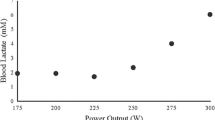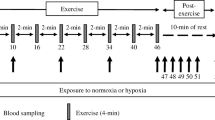Summary
It was the purpose of this study to determine the effects of respiratory alkalosis before and after high intensity exercise on recovery blood lactate concentration. Five subjects were studied under three different acid-base conditions before and after 45 s of maximal effort exercise: 1) hyperventilating room air before exercise (Respiratory Alkalosis Before=RALB, 2) hyperventilating room air during recovery (Respiratory Alkalosis After=RALA), and 3) breathing room air normally throughout rest and recovery (Control =C). RALB increased blood pH during rest to 7.65±0.03 while RALA increased blood pH to 7.57±0.03 by 40 min of recovery. Neither alkalosis treatment had a significant effect on blood lactate concentration during recovery. The peak lactate values of 12.3±1.2 mmol · L−1 for C, 11.8±1.2 mmol · L−1 for RALB, and 10.2±0.9 mmol · L−1 for RALA were not significantly different, nor were the half-times (t 1/2) for the decline in blood lactate concentration; C=18.2 min, RALB=19.3 min, and RALA=18.2 min. In C, RALB and RALA, the change in base excess from rest to postexercise was greater than the concomitant increase in blood lactate concentration, suggesting the presence of a significant amount of acid in the blood in addition to lactic acid. There was no significant difference in either the total number of cycle revolutions (C=77±2, RALB=77±1) or power output at 5 s intervals between RALB and C during the 45 s. These results suggest that the possible range of respiratory alkalosis changes in intact humans may be insufficient 1) to affect recovery blood lactate concentrations, or 2) to affect intense, short-term exercise performance.
Similar content being viewed by others
References
Bouhuys A, Pool J, Binkhorst RA, Van Leeuwen P (1966) Metabolic acidosis of exercise in healthy males. J Appl Physiol 21:1040–1046
Burnell JM (1968) In vivo response of muscle to changes in CO2 tension or extracellular bicarbonate. Am J Physiol 215:1376–1383
Costill DL, Verstappen F, Kuipers H, Janssen E, Fink W (1984) Acid-base balance during repeated bouts of exercise: influence of HCO3. Int J Sports Med 5:228–231
Davies SF, Iber C, Keene SA, McArthur CD, Path MJ (1986) Effect of respiratory alkalosis during exercise on blood lactate. J Appl Physiol 61:948–952
Dobson GP, Yamamoto E, Hochachka PW (1986) Phosphofructokinase control in muscle: nature and reversal of pH-dependent ATP inhibition. Am J Physiol 250:R71-R76
Doll E, Keul J, Maiwald C (1968) Oxygen tension and acid-base equilibria in venous blood of working muscle. Am J Physiol 215:23–29
Ehrsam RE, Heigenhauser GJF, Jones NL (1982) Effect of respiratory acidosis on metabolism in exercise. J Appl Physiol 53:63–69
Eldridge F, Salzer J (1967) Effect of respiratory alkalosis on blood lactate and pyruvate in humans. J Appl Physiol 22:461–468
Forster HV, Dempsey JA, Thomson J, Vidruk E, DoPico GA (1972) Estimation of arterial\(P_{{\text{O}}_{\text{2}} } , P_{{\text{CO}}_{\text{2}} } \), pH, and lactate from arterialized venous blood. J Appl Physiol 32:134–137
Gerin-Portier N (1971) Effect of O2 desaturation on the determination of blood\(P_{{\text{CO}}_{\text{2}} } \) by the Astrup method. Respir Physiol 12:261–268
Graham TE, Wilson BA, Sample M, Van Dijk J, Goslin B (1982) The effects of hypercapnia on the metabolic response to steady-state exercise. Med Sci Sports Exerc 14:286–291
Greenhaff PL, Maughan RJ (1987) Respiratory alkalosis and the performance of high-intensity exercise in man. J Physiol 386:68P
Gutmann I, Wahlefeld AW (1974) L-(+)-lactate. Determination with lactate dehydrogenase and NAD. In: Bergmeyer U (ed) Methods of enzymatic analysis 2nd ed. Academic Press Inc., New York, pp 1464–1468
Hirche HJ, Hombach V, Langohr HD, Wacker U, Busse J (1975) Lactic acid permeation rate in working gastrocnemii of dogs during metabolic alkalosis and acidosis. Pflügers Arch 356:209–222
Hughes EF, Turner SC, Brooks GA (1982) Effects of glycogen depletion and pedaling speed on “anaerobic threshold”. J Appl Physiol 52:1598–1607
Hultman E, Sahlin K (1980) Acid-base balance during exercise. Exercise Sport Sci Rev 8:41–128
Jones NL, Sutton JR, Taylor R, Toews CJ (1977) Effect of pH on cardiorespiratory and metabolic responses to exercise. J Appl Physiol 43:959–964
Katz A, Sahlin K, Juhlin-Dannfelt A (1985) Effect ofβ-adrenoceptor blockade onH + andK + flux in exercising humans. J Appl Physiol 59:336–341
Mainwood GW, Renaud JM (1985) The effect of acid-base balance on fatigue of skeletal muscle. Can J Physiol Pharmacol 63:403–416
Mainwood GW, Worsley-Brown P (1975) The effects of extracellular pH and buffer concentration on the efflux of lactate from frog sartorius muscle. J Physiol (Lond) 250:1–22
Manfredi F (1963) Calculation of total body intracellular pH in normal human subjects from the distribution of 5,5-dimethyl-2,4-oxazolidinedione (DMO). J Lab Clin Med 61:1005–1014
Manfredi F (1967) Effects of hypocapnia and hypercapnia on intracellular acid-base equilibrium in man. J Lab Clin Med 69:304–312
McCartney N, Heigenhauser GJF, Jones NL (1983) Effects of pH on maximal power output and fatigue during shortterm dynamic exercise. J Appl Physiol 55:225–229
Medbo JI, Sejersted OM (1985) Acid-base and electrolyte balance after exhausting exercise in endurance-trained and sprint-trained subjects. Acta Physiol Scand 125:97–109
Osnes J-B, Hermansen L (1972) Acid-balance after maximal exercise of short duration. J Appl Physiol 32:59–63
Roos A (1975) Intracellular pH and distribution of weak acids across cell membrane. A study of D- and L-lactate and of DMO in rat diaphragm. J Physiol (Lond) 249:1–25
Roos A, Boron WF (1981) Intracellular pH. Physiol Rev 61:297–434
Sahlin K, Alvestrand A, Brandt R, Hultman E (1978) Acid-base balance in blood during exhaustive bicycle exercise and the following recovery period. Acta Physiol Scand 104:370–372
Severinghaus JW (1958) Oxyhemoglobin dissociation curve correction for temperature and pH variation in human blood. J Appl Physiol 12:485–486
Siggaard-Andersen O (1974) The acid-base status of the blood 4th ed. Williams & Wilkins, Baltimore
Spriet LL, Lindinger MI, Heigenhauser GJF, Jones NL (1986) Effects of alkalosis on skeletal muscle metabolism and performance during exercise. Am J Physiol 251:R833–839
Sutton JR, Jones NL, Toews CJ (1981) Effect of pH on muscle glycolysis during exercise. Clin Sci 61:331–338
Trivedi B, Danforth WH (1966) Effect of pH on the kinetics of frog muscle phosphofructokinase. J Biol Chem 241:4110–4114
Author information
Authors and Affiliations
Rights and permissions
About this article
Cite this article
Morrow, J.A., Fell, R.D. & Gladden, L.B. Respiratory alkalosis: no effect on blood lactate decline or exercise performance. Europ. J. Appl. Physiol. 58, 175–181 (1988). https://doi.org/10.1007/BF00636623
Accepted:
Issue Date:
DOI: https://doi.org/10.1007/BF00636623




